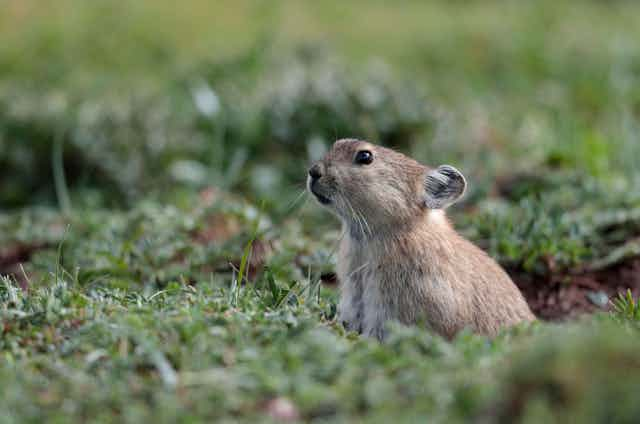Known as the water tower of Asia, the Tibetan Plateau is where the mighty Yellow, Yangtze and Mekong rivers begin as tiny trickles. The plateau is also sometimes referred to as the roof of the world – a vast plain raised 4,500 metres above sea level and surrounded on all sides by imposing mountain ranges, one of which includes Mount Everest. For the 1.4 billion people living downstream, the plateau is an irreplaceable source of fresh water.
For the nomadic people who live here, the plateau is their livelihood. But half of the meadows in the region are at risk of turning into black soil – the eventual fate of degraded alpine meadows. Local communities who rely on the plateau’s pastures to graze their cattle and sheep often blame pika, a small, rabbit-like mammal on which the Pokemon character Pikachu is based. But is this really fair?
Black soil patches occur when plants and grass turf have been completely lost from a meadow, and their emergence can be accelerated by the burrowing of plateau pikas. Tibetan nomads think the arrival of pikas from degraded pastures several kilometres away heralds the downfall of their own pasture. Traditional beliefs maintain that pikas arrive riding on the backs of snow finches, but Buddhist thought discourages nomads from killing them. Instead, they often invite monks to say pika-expelling prayers.
Despite their certainty, the pika’s role in the degradation of the plateau’s pastures is actually rather complex, as my research reveals. Far from condemning this tiny herbivore, the evidence points to a greater villain: recent changes to how the land here is managed.
Pikas in the dock
Plateau pikas are timid animals and prefer to live in grassland that is less than 10cm high. Short-grass pastures with bare soil patches allow them to better see their predators, such as the upland buzzard.
Pikas also have similar taste in plants to the Tibetan Plateau’s 14 million yaks – the long-haired domestic cattle which share their pasture and typically feed within ten metres of their burrows. Once pikas move into an area of pasture, their feeding reduces the amount of palatable plants, so yaks graze neighbouring areas of untouched taller grass. This grazing then creates better habitats for pikas, especially during the summer when the average family size of pikas swells.

Plateau pikas can produce up to five litters a year, so the grazing intensity of domestic yaks has to be controlled to prevent them making lots of habitat well-suited to pika, to limit how fast and high pika populations grow.
But herding livestock is time consuming, and this kind of land management is not always in place. In many parts of the plateau’s meadow regions, livestock numbers peaked in the 1980s and 1990s, when they were two to three times higher than they were in the early 1960s. Rangeland once held in common was parcelled up to individual households in the 1990s. By the early 2000s, now-sedentary nomads began installing metal fences along the boundaries of their land to prevent their livestock from wandering off and to help keep them safe from wolves. This meant shepherds no longer had to watch over and herd their livestock.
Confined inside fences, however, yak and sheep can graze wherever they like, mowing and trampling the grass. When pikas are nearby, it’s easy for them to cross over fences and disperse into these overgrazed patches. The result of nomads being unable to move their livestock as freely as before is the intensive grazing that has provided the ideal environment for these small mammals to thrive in.
The verdict
The plateau provides a home to around 6 million herders. Expanding black soil patches on the grassland threaten their livelihood and, while pika numbers continue to increase, the scientific community is divided over the best response.
Some believe the little creatures should be culled, while others argue they play a critical role at the bottom of the food chain, supporting populations of foxes, weasels, pole cats and birds of prey, and so must be protected.
The plateau pika does play a central role in this crisis, but land-use changes among local nomads are the real issue. Keeping grass higher than 10cm would mean less food for yaks, and most nomads can’t afford the shortfall in meat, butter and milk they derive from their livestock. Government subsidies which are more accurately tied to each family’s herd size could compensate nomads for leaving areas free from grazing.
The key to saving the plateau’s meadows, then, is not to demonise the pika, but to develop a culturally acceptable solution that both controls this wild mammal’s populations and allows pastoral nomads to continue making a living.

